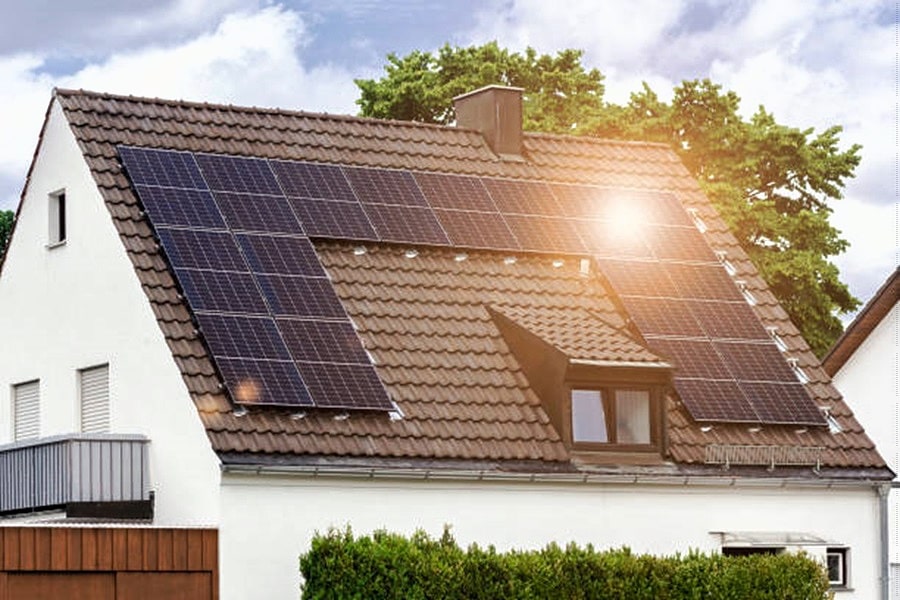The shift towards renewable energy is gaining momentum across Australia, with more homeowners embracing the sun’s power to fuel their daily lives. Solar panel installation is at the forefront of this movement, offering a sustainable and cost-effective alternative to traditional electricity sources. However, before joining the solar revolution, it’s crucial to prepare your home and ensure it’s ready for this significant upgrade. This guide aims to walk you through the essential steps and considerations for preparing your home for solar panel installation, ensuring a smooth transition to greener energy.
Understanding solar panel installation
Solar panel installation is a process that not only promises to reduce your carbon footprint but also to lower electricity bills significantly. But what does it involve, and why is preparation so important?
- The process: Installing solar panels typically involves assessing your energy needs, choosing the right system, and then mounting the solar panels on your roof. This is followed by wiring the panels to your home’s electrical system and installing any additional equipment, such as inverters or batteries.
- The benefits: For Australian homeowners, the benefits of solar panel installation are manifold. Firstly, solar energy can significantly reduce your electricity bills. Secondly, it increases your property’s value. Thirdly, it reduces your household’s carbon emissions, contributing to a healthier environment.
- Why preparation matters: Proper preparation ensures that your solar panel system is not only installed efficiently but also performs optimally over its lifespan. From roof inspections to choosing the right type of solar panel, each step in the preparation process plays a crucial role in maximising the benefits of your new solar system.
Embracing solar energy is a commendable step towards sustainability and energy independence. By understanding the installation process and the importance of thorough preparation, you can ensure that your journey to solar energy is successful and rewarding.
Initial considerations before installation
Before leaping into the solar revolution, several foundational steps need to be taken to ensure your home is ready for this energy transition.
- Assess your energy usage: Understanding your current energy consumption is crucial. Look at your electricity bills over the past year to get an average. This will help in determining the size of the solar system that would best suit your needs.
- Inspect your roof: The condition, material, and orientation of your roof play significant roles in the efficiency of your solar panels. Ensure that your roof is in good condition and free from shading for most of the day. North-facing roofs typically capture the most sunlight.
- Check for permits and restrictions: Depending on your location, there may be specific regulations, permits, or homeowners association rules regarding solar panel installations. It’s essential to be aware of these requirements beforehand to avoid any legal issues.
- Budgeting: Solar installations are an investment. While the long-term savings are substantial, it’s important to plan your finances, considering both the installation costs and any potential subsidies or rebates.
Choosing the right solar panel system
Picking the appropriate solar panel system is more than just about the budget; it’s about maximising efficiency and meeting your energy needs.
Types of solar panels
Solar panels come in various types, including monocrystalline, polycrystalline, and thin-film, each with its own set of advantages and efficiency rates. Monocrystalline panels, known for their high efficiency and durability, might be ideal for homes with limited roof space, whereas polycrystalline panels can offer a balance between efficiency and cost-effectiveness. Thin-film panels, though less efficient per square meter, can be a good choice for large, unobstructed roofs.
Inverters and batteries
The inverter is a crucial component that converts solar energy into electricity you can use in your home. Choosing the right inverter can significantly impact the efficiency of your solar system. Additionally, consider whether you want to incorporate battery storage into your system to store excess energy for later use.
System size and capacity
Based on your energy assessment, decide on the size of the solar system. It should meet your daily energy needs and fit within your budget while considering future energy consumption changes.
Get multiple quotes
Before making a decision, it’s wise to compare options. Use services like Energy Matters’ FREE solar quotes to get estimates from multiple providers. This will not only give you a sense of the market but also help in finding the best deal tailored to your specific needs and location.
Choosing the right solar panel system for your home is a critical step towards a successful solar installation. By carefully considering your options and making informed decisions, you can ensure that your solar investment is cost-effective, efficient, and tailored to your energy needs.
Ready to upgrade your solar systems and take your energy savings to the next level? Embrace the energy efficiency revolution by upgrading your solar systems and adding a battery, solar inverters + more with Energy Matters. Energy Matters has been recognised for our continued excellence in the Australian solar industry. We provide our customers with high-quality resources, insight, and access to reputable solar quotes.
With Energy Matters’ 3 free solar quotes, you can compare plans from pre-qualified and vetted installers in your area and find the perfect solution for your home and business. Harness the sun’s power and save money on electricity bills while reducing environmental impact. Let Energy Matters guide you towards a brighter, more sustainable future.
How to prepare your home for solar panel installation
Once you’ve decided on the right solar panel system for your home, the next step is preparing your property for installation. This phase is crucial for ensuring that the installation process goes smoothly and efficiently.
- Roof preparation: Ensure your roof is ready to support solar panels. This might involve repairing or reinforcing your roof, cleaning it, or even trimming nearby trees that could cast shade and reduce the efficiency of your panels.
- Access: Make sure there is clear access to your roof for the installation team. This includes securing pets and moving any vehicles or garden furniture that could obstruct access.
- Electrical system check: It’s a good idea to have your home’s electrical system checked by a professional electrician. This ensures it is in good condition and capable of integrating with your new solar system. This can usually be completed by the solar installation team and may require a switchboard upgrade.
- Understand your energy consumption: Analyse your electricity bills to determine your average daily usage. This information helps select the appropriate solar panel size for your energy needs.
- Understand solar panel placement: Familiarise yourself with the proposed layout of the solar panels. Knowing about solar panel sizes and how they will fit on your roof can help you visualise the installation and discuss any concerns with the installer before the work begins.
- Consider your financial situation: To maximise your investment, explore available incentives, rebates, and solar feed-in tariffs. Develop a budget and consider financing options if necessary.
- Choose a reputable installer: Research and select a qualified solar installer with a proven track record. Read reviews, check certifications, and request multiple quotes for comparison.
Installation day: What to expect
The big day has arrived! Here’s what you can typically expect on the day your solar panels are installed:
- Early start: Installation teams often start early in the day to take advantage of the full daylight hours, so be prepared for an early morning.
- Installation team arrives: A team of professional installers will arrive, equipped with all the necessary tools and components for your solar system. They’ll introduce themselves and go over the plan for the day with you.
- Safety first: The team will set up safety equipment and secure the area. It’s important for household members to keep a safe distance from the work area during the installation.
- Mounting and wiring: The installers will begin by setting up the mounting system for your solar panels, followed by placing the panels themselves and connecting the system to your home’s electrical grid.
- Testing: Once everything is installed, the system will be tested to ensure it’s operating correctly. This includes checking the inverter, the panels, and the connection to the electrical grid.
- Clean-up: After the installation is complete and everything is tested, the installation team will clean up the work area, leaving your property as they found it.
- Final walkthrough: Finally, the team will do a walkthrough with you, explaining how the system works, how to monitor it, and any maintenance or care instructions.
Installation day can be exciting and a bit nerve-wracking, but knowing what to expect can ease some of that anxiety. With the right preparation and a professional installation team, your home will soon be powered by clean, renewable solar energy.
Post-installation checklist
After the installation team has left and your solar panels are gleaming in the sunlight, there are a few important steps to ensure everything is set for optimal performance:
- System registration: Ensure your solar system is registered with your local utility company if necessary. This step is crucial for grid-connected systems to qualify for any feed-in tariffs or net metering benefits.
- Documentation: Keep all your installation documents, warranties, and user manuals in a safe place. These documents are invaluable for any future maintenance, warranty claims, or if you decide to sell your home.
- Monitoring setup: Familiarise yourself with the solar monitoring system. This technology allows you to track the performance of your solar panels, including energy production and consumption. Understanding how to use this tool can help you maximise your solar benefits.
- Inspect regularly: While solar panels require minimal maintenance, regular visual inspections can help identify potential issues like debris buildup or damage. Cleaning your panels occasionally, especially if you’re in a dusty area or have lots of bird activity, can maintain their efficiency.
- Energy usage review: After a few billing cycles, review your energy bills to see the impact of your solar panels. This review can provide insights into your energy consumption patterns and potential additional savings.
Maximising the benefits of solar panels
To truly reap the rewards of your solar panel investment, consider these strategies:
Smart energy use
Try to use more energy during daylight hours when your panels are producing power. This approach can include scheduling the use of high-energy appliances like washing machines during peak sunlight times.
Energy storage
If your system includes a battery, use stored energy during peak tariff times to further reduce your electricity bills. Batteries are a great way to ensure you’re using solar energy around the clock.
Stay informed
Keep abreast of changes in energy policy, new solar technologies, or financial incentives. The solar energy landscape is continually evolving, and new opportunities to save or even earn money from your system may arise.
Maintenance checks
Though low, consider scheduling professional maintenance checks every few years to ensure your system is functioning optimally. A professional can spot issues you may miss and help prolong the life of your solar investment.
Embracing solar energy is a smart move for both the planet and your pocket. With the right preparation, installation, and post-installation care, your solar panels can provide significant savings and environmental benefits for years to come. Remember, the key to maximising these benefits lies in understanding your system, smart energy practices, and regular maintenance.
Conclusion
Transitioning to solar energy is an exciting journey that promises not only to reduce your carbon footprint but also to offer substantial savings on energy costs. Preparing your home for solar panel installation is a crucial step that requires careful planning and consideration. By following the checklist provided, you can ensure that your home is ready to harness the power of the sun efficiently. From assessing your energy needs to choosing the right solar panel system, and preparing your home for the big day, each step brings you closer to a sustainable and cost-effective energy solution. Remember, the key to a successful solar panel installation lies in meticulous preparation and making informed decisions.
FAQ
How long do solar panels last?
Solar panels are built to last and typically come with a warranty of 25 to 30 years. However, many panels continue to function well beyond their warranty period, albeit with slightly reduced efficiency.
Will solar panels increase my property value?
Yes, solar panels can increase your property value. Homes with solar panel installations often sell at a premium compared to those without, reflecting the future energy savings the panels provide.
Do I need to replace my roof before installing solar panels?
If your roof is in good condition, you may not need to replace it before installation. However, if your roof is nearing the end of its lifespan or has significant damage, it’s advisable to make repairs or replace it beforehand to avoid having to remove and reinstall the panels later.
Can I install solar panels myself?
While it’s technically possible to install solar panels yourself, it’s highly recommended to use a professional installer. Professional installation ensures that the system is correctly set up, maximises efficiency, and adheres to safety standards and local regulations. In order to receive STCs for your system, you will need a licenced and Solar Accreditation Australia (SAA) accredited installer to install your solar panels.
What maintenance do solar panels require?
Solar panels require minimal maintenance. Regular visual inspections and occasional cleaning to remove dirt, leaves, or snow are generally sufficient to keep them functioning optimally.












































